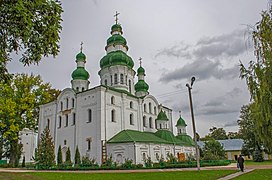
Chernihiv
Chernihiv (Ukrainian: Чернігів, IPA: [tʃerˈn⁽ʲ⁾iɦiu̯] ; Russian: Чернигов, romanized: Chernigov, IPA: [tɕɪrˈnʲiɡəf]) is a city and municipality in northern Ukraine, which serves as the administrative center of Chernihiv Oblast and Chernihiv Raion within the oblast.[3] Chernihiv's population is 282,747 (2022 estimate).[4]
Not to be confused with Chernivtsi.
Chernihiv
Чернігів
907
79 km2 (31 sq mi)
136 m (446 ft)
282,747
1,547/km2 (4,010/sq mi)
(+380) 462
CB / 25
The city was designated as a Hero City of Ukraine by the Ukrainian government during the 2022 Russian invasion of Ukraine.[5]
Names and etymology[edit]
The name "Chernihiv" is a compound name, which begins with the root 'Cherni/Cherno,' which means "black" in Slavic.[6] Scholars vary with interpretations of the second part of the name ("hiv"/gov", "говъ") though scholars such as Dr. Martin Dimnik, Professor of Medieval History at University of Toronto, connect Chernihov with the worship of "the black god" Chernibog.[7]
The city of Chernihiv is also historically known by different names in other languages – Russian: Чернигов, romanized: Chernigov, IPA: [tɕɪrˈnʲiɡəf]; Polish: Czernihów; Yiddish: טשערניגאָב.
History[edit]
Early history[edit]
Chernihiv was first mentioned (as Черниговъ) in the Rus'–Byzantine Treaty (907), but the time of its establishment is unknown.[8] Artifacts from the Khazar Khaganate uncovered by archaeological excavations at a settlement there indicate that it seems to have existed at least as early as the 9th century. Towards the end of the 10th century, the city probably had its own rulers. It was there that the Black Grave, one of the largest and earliest royal mounds in Eastern Europe, was excavated in the 19th century.
The city was the second wealthiest and most important in the southern portion of the Kievan Rus'.[9] From the early 11th century on, it was the seat of the powerful Principality of Chernigov, whose rulers at times vied for power with Kievan Grand Princes, and often overthrew them and took the primary seat in Kiev for themselves.
The grand principality was the largest in Kievan Rus and included not only the Severian towns but even such remote regions as Murom, Ryazan and Tmutarakan. The golden age of Chernigov, when the city population peaked at 25,000, lasted until 1239 when the city was sacked by the hordes of Batu Khan, and entered a long period of relative obscurity.
The area fell under the Grand Duchy of Lithuania in 1353. The city was burned again by Crimean khan Meñli I Giray in 1482 and 1497 and in the 15th to 17th centuries changed hands several times between Lithuania, Muscovy (1408–1420 and from 1503), and the Polish-Lithuanian Commonwealth (1618–1648), where it was granted Magdeburg rights in 1623 and in 1635 became a seat of Chernihiv Voivodeship in the Lesser Poland Province.
The area's importance increased again in the middle of the 17th century during and after the Khmelnytsky Uprising. In the Hetman State Chernihiv was the city of deployment of Chernihiv Cossack regiment (both a military and territorial unit of the time).
Imperial Russia[edit]
Under the 1667 Treaty of Andrusovo the legal suzerainty of the area was ceded to the Tsardom of Russia, with Chernihiv remaining an important center of the autonomous Cossack Hetmanate. With the abolishment of the Hetmanate, the city became an ordinary administrative center of the Russian Empire and a capital of local administrative units. The area in general was ruled by the Governor-General appointed from Saint Petersburg, the imperial capital, and Chernihiv was the capital of local namestnichestvo (province) (from 1782), Malorosiyskaya or Little Russian (from 1797) and Chernigov Governorate (from 1808).
According to the census of 1897, the city of Chernihiv had 11,000 Jews out of a total population of 27,006. Their primary occupations were industrial and commercial. Many tobacco plantations and fruit gardens in the neighborhood were owned by Jews. There were 1,321 Jewish artisans in Chernihiv, including 404 tailors and seamstresses, but the demand for artisan labor was limited to the town. There were 69 Jewish day-laborers, almost exclusively teamsters. Few, however, were employed in factories.[10][11]
World War II[edit]
During World War II, Chernihiv was occupied by the German Army from 9 September 1941 to 21 September 1943. The Germans operated a Nazi prison[12] and a forced labour battalion for Jews in the city.[13]
Independent Ukraine[edit]
The Statue of Lenin on Myru Avenue was toppled on February 21, 2014, as part of the demolitions of the statues of Lenin in Ukraine.[14][15]
Until 18 July 2020, Chernihiv was designated as a city of oblast significance and did not belong to Chernihiv Raion even though it was the center of the raion. As part of the administrative reform of Ukraine, which reduced the number of raions of Chernihiv Oblast to five, the city was merged into Chernihiv Raion.[16][17]
In June 2022, Chernihiv signed an agreement with Rzeszów, Poland to become sister cities.[18][19]
Economy[edit]
Industry[edit]
Cheksil, one of the largest enterprises in the Ukrainian textile industry, is based in Chernihiv. The first stage of the plant was put into operation in 1963.[35] The city also has the Chernihiv Musical Instrument Factory established in 1933. In 1995 a manufacturer of goods for animals, called COLLAR Company, was established by Yuri Sinitsa.[36][37][38]


































